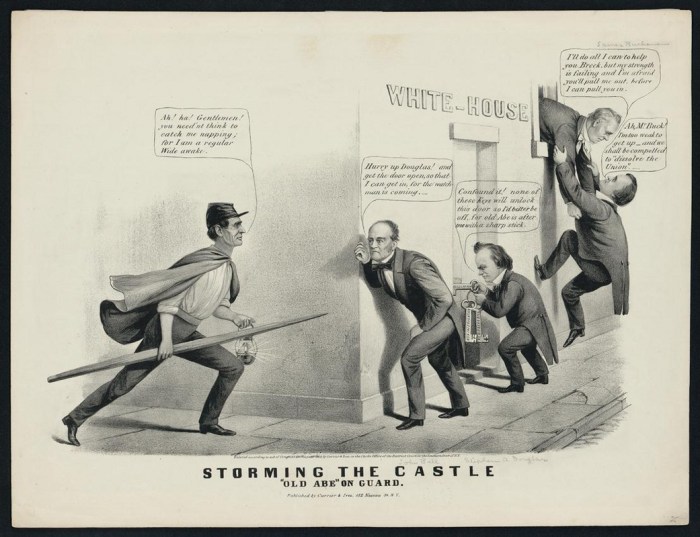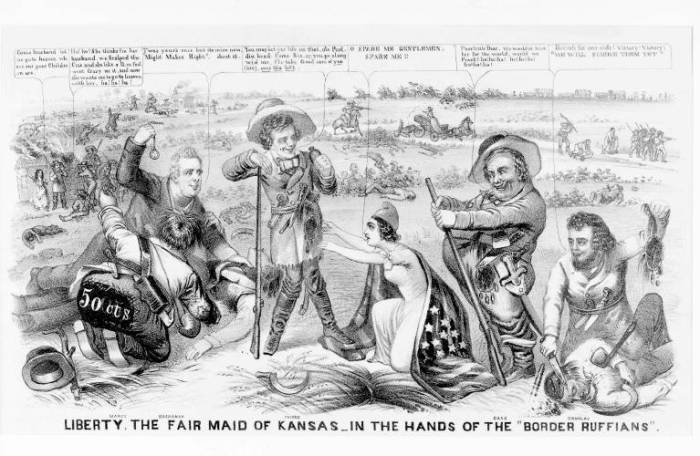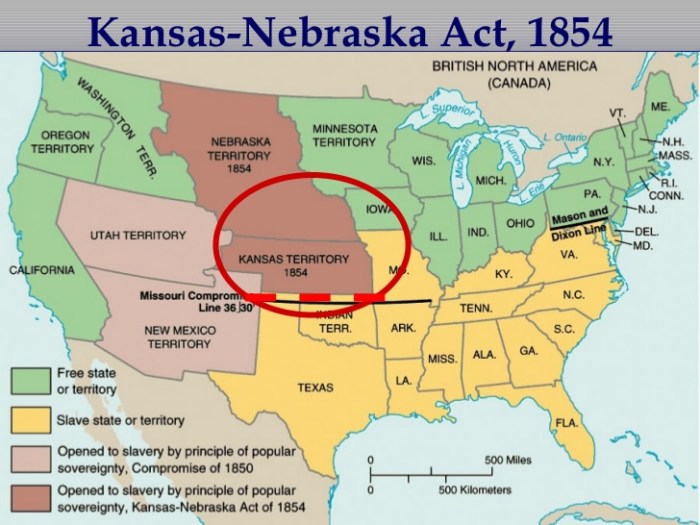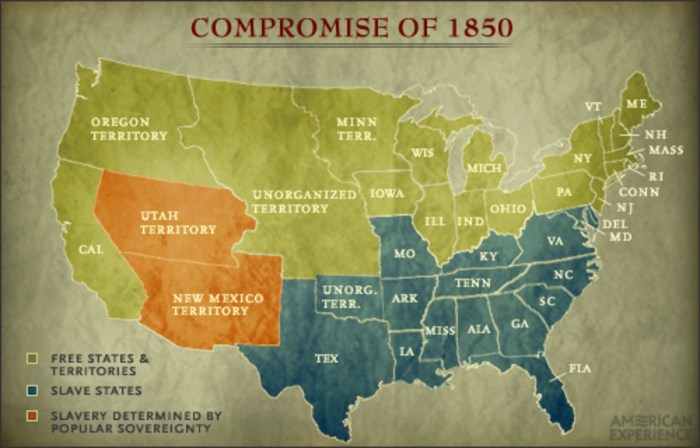Kansas nebraska act political cartoon – The Kansas-Nebraska Act political cartoon is a powerful and thought-provoking depiction of the political landscape in the United States in the mid-19th century. This cartoon offers a unique perspective on the historical significance of the Act and its enduring relevance to contemporary debates about race and politics.
The Act, passed in 1854, repealed the Missouri Compromise of 1820 and allowed for the expansion of slavery into the territories of Kansas and Nebraska. This decision ignited a firestorm of controversy and led to increased tensions between the North and the South, ultimately contributing to the outbreak of the Civil War.
Historical Context

The Kansas-Nebraska Act of 1854 was a pivotal piece of legislation that significantly altered the political landscape of the United States and played a crucial role in the escalation of tensions that eventually led to the Civil War.
The Act, introduced by Democratic Senator Stephen A. Douglas of Illinois, repealed the Missouri Compromise of 1820, which had prohibited slavery in the Louisiana Purchase territory north of the 36°30′ parallel. The Kansas-Nebraska Act instead allowed the territories of Kansas and Nebraska to determine the legality of slavery through popular sovereignty, a principle that gave residents the right to vote on the issue.
Political Motivations
The passage of the Kansas-Nebraska Act was driven by several political motivations. Douglas, who sought to expand his influence in the West and strengthen the Democratic Party, believed that popular sovereignty would allow the people of Kansas and Nebraska to resolve the issue of slavery peacefully.
Southern slaveholders, who had long advocated for the expansion of slavery into new territories, supported the Act as a means of protecting their economic interests. They feared that the spread of free states would eventually lead to the abolition of slavery.
Impact on Slavery Expansion
The Kansas-Nebraska Act had a profound impact on the expansion of slavery in the United States. The Act opened up new territories to potential slaveholding, and the subsequent struggle over the issue of slavery in Kansas led to violent conflict and deepened sectional divisions.
The Act also contributed to the rise of the Republican Party, a new political party formed by opponents of the expansion of slavery. The Republican Party went on to play a major role in the election of Abraham Lincoln in 1860 and the outbreak of the Civil War in 1861.
Political Cartoon Analysis

The political cartoon titled “The Kansas-Nebraska Act” employs a combination of visual metaphors and symbolic imagery to convey its message. Through these elements, the cartoonist effectively communicates their stance on the controversial act.
Symbols and Metaphors
- Slavery: The central figure in the cartoon, a slave auctioneer, represents the institution of slavery and its expansionist ambitions.
- Kansas and Nebraska: The two territories depicted as women being auctioned off symbolize the political struggle over their status as slave or free states.
- Auction Block: The auction block serves as a metaphor for the political bargaining and compromise that characterized the Kansas-Nebraska Act.
Intended Audience and Impact
The intended audience of the cartoon was likely the general public, particularly those interested in the political debates surrounding the Kansas-Nebraska Act. The cartoon’s message would have resonated with abolitionists and opponents of slavery expansion, as it highlighted the potential consequences of the act.
Historical Interpretations: Kansas Nebraska Act Political Cartoon

The Kansas-Nebraska Act has been subject to various historical interpretations that have evolved over time, shaped by political perspectives and the availability of new evidence.
Initially, the Act was seen as a triumph for proponents of popular sovereignty, who believed it would allow settlers to decide the issue of slavery in the territories. However, the Act’s consequences, including the outbreak of “Bleeding Kansas” and the escalation of sectional tensions, led to a reevaluation of its significance.
Changing Interpretations
In the years following the Civil War, the Act was often portrayed as a catalyst for the conflict, with its passage seen as a deliberate attempt to expand slavery into new territories.
In the early 20th century, historians began to emphasize the role of economic factors in the passage of the Act, arguing that it was driven by a desire to promote the expansion of railroads and settlement in the West.
More recent scholarship has focused on the political motivations of the Act’s proponents, particularly the desire to appease Southern slaveholders and maintain the balance of power in the Senate.
Role of the Political Cartoon
Political cartoons played a significant role in shaping public opinion about the Kansas-Nebraska Act and its consequences. Cartoons often depicted the Act as a tool of Southern slaveholders or as a threat to the Union.
These cartoons helped to galvanize opposition to the Act and contributed to the growing sectional tensions that led to the Civil War.
Contemporary Relevance

The Kansas-Nebraska Act and the associated political cartoon continue to resonate in contemporary debates about race and politics. The cartoon highlights the tensions between pro-slavery and anti-slavery factions during the 19th century, and it can provide valuable insights into current discussions about race and equality.
Understanding Current Events
The cartoon illustrates the use of political rhetoric to justify actions that perpetuate racial inequality. The depiction of “Uncle Sam” as a passive observer while slavery is forced upon the territories of Kansas and Nebraska mirrors contemporary debates about the role of government in addressing racial disparities.
Importance of Historical Context, Kansas nebraska act political cartoon
Understanding the historical context of the Kansas-Nebraska Act is crucial for interpreting the cartoon and its relevance to contemporary issues. By examining the events and attitudes that shaped the 19th-century debate, we can gain insights into the origins of racial inequality and the challenges faced in addressing it today.
Essential Questionnaire
What was the main purpose of the Kansas-Nebraska Act?
The main purpose of the Kansas-Nebraska Act was to repeal the Missouri Compromise of 1820 and allow for the expansion of slavery into the territories of Kansas and Nebraska.
What were the political motivations behind the passage of the Kansas-Nebraska Act?
The political motivations behind the passage of the Kansas-Nebraska Act were complex, but they primarily involved the desire to appease Southern slaveholders and to maintain the balance of power between the North and the South.
What was the impact of the Kansas-Nebraska Act on the expansion of slavery in the United States?
The Kansas-Nebraska Act had a significant impact on the expansion of slavery in the United States. It opened up new territories to slavery and led to increased tensions between the North and the South.
